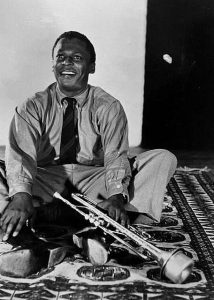| Experience the Journey of a Jazz Legend |
Miles Davis in Paris : Few musicians in history have shaped jazz like Miles Davis. When he first set foot in Paris, he found a city that would change him forever — a place where he was valued for his talent, not the color of his skin. Paris allowed Davis to explore not only his music but also his identity, giving him a sense of freedom that was painfully elusive back in the United States. Today, PARIS BY EMY offers a private tour dedicated to exploring the life and times of Miles Davis in the City of Lights, providing jazz enthusiasts an intimate look at this icon’s journey.
Background: Who Was Miles Davis?
Early Life and Rise in Jazz
Born in Alton, Illinois, in 1926, Miles Davis was a trumpet prodigy who would later become one of the most influential jazz musicians in history. His early life was marked by a relentless pursuit of musical perfection, and by his early 20s, Davis was performing alongside legends such as Charlie Parker. Known for his unique approach to jazz, Davis’s career spanned nearly five decades, during which he constantly reinvented his sound and style.
Defining Sound and Lasting Influence
Davis was a master of reinvention. His music evolved from bebop to cool jazz, hard bop, modal jazz, and fusion, influencing countless musicians and listeners around the world. His sound was distinct, often characterized by haunting tones, muted trumpet passages, and a profound sense of emotional depth.

Miles Davis’s First Trip to Paris
Paris Initial Visit and Connections for Miles Davis
In 1949, Miles Davis visited Paris for the first time, performing at the “Festival International de Jazz” in May of that year. It was during this visit that he met French celebrities and intellectuals, including the renowned philosopher Jean-Paul Sartre and the singer-actress Juliette Gréco. The warm reception Davis received from the Parisians was transformative, showing him a world starkly different from the one he knew back home.
Miles Davis in Paris – A Haven from Racial Segregation
While racial segregation plagued the United States, Paris offered Davis an atmosphere of freedom and respect. In France, he was celebrated purely for his talent and contributions to the jazz genre. This cultural openness deeply influenced him, allowing him to focus solely on his art without the oppressive discrimination he had faced back home.
Influence of the Parisian Jazz Scene on Davis
The Lively Jazz Scene of Paris
Paris in the late 1940s and early 1950s was a thriving hub for jazz. Clubs like the “Club Saint-Germain” and “Le Tabou” were alive with the sounds of the latest jazz tunes. Parisian audiences, artists, and intellectuals were enamored with jazz, and this energy fueled Davis’s own creativity, making the city a fertile ground for his musical growth.
Miles Davis in Paris – Iconic Clubs and Concert Halls
Among the places where Davis performed, venues like “Salle Pleyel” and “Olympia” stand out. These historic venues were not only central to the jazz scene but also became legendary spaces where Davis’s performances left a lasting impact on the Parisian audience. Each venue holds a place in the history of jazz, echoing with the memories of his groundbreaking performances.
The Influence of French Artists on Miles Davis in Paris
While in Paris, Davis connected with writers, painters, and intellectuals who valued artistic expression above all else. Figures like Jean-Paul Sartre and other Existentialists shared a philosophy that resonated with Davis. These interactions opened Davis’s mind to new ways of interpreting the world and influenced his compositions.
French jazz pianist René Urtreger adds: “Miles was proud and touched by the fact that in France, jazz was considered to be very important music.”
The Miles Davis and Tadd Dameron quintet played at the Salle Pleyel concert hall, and Davis was soon befriended by Boris Vian, a 29-year-old French polymath, with numerous talents included writing, poetry, engineering, songwriting and playing jazz trumpet. Vian introduced Davis to Picasso and Jean-Paul Sartre, and the group would sit together in hotels, cafes and clubs in the Saint-Germain district.
Romance in Paris: Miles and Juliette Gréco
Miles’s relationship with Juliette Gréco was a central chapter of his Parisian experience. Gréco, a celebrated French singer, and actress, was known for her deep, emotional style, which complemented Davis’s own introspective nature. Their romance was a melding of two artists from different worlds, creating a unique bond that Davis would remember throughout his life.
“It changed the way I looked at things forever … I loved being in Paris and loved the way I was treated. Paris was where I understood that all white people were not the same; that some weren’t prejudiced.”
Return to the U.S.: Changed Perspective and Sound
When Davis returned to the United States, he brought with him a renewed outlook on life and music. The warmth and acceptance he experienced in Paris left a profound impression on him, and it influenced his subsequent musical projects. He began exploring modal jazz, a style that would lead to his legendary album Kind of Blue.
However, America, jazz was in crisis. Clubs were closing down and gigs becoming harder to find. Depressed, Davis became a heroin addict. It would take him four years to kick the habit.
In 1956, a cleaned-up Davis returned to Paris for the start of a European tour featuring the Birdland All Stars. The following year, he returned to Paris for another tour and was joined again by Urtreger. Around the same time, Davis was asked by French director Louis Malle to compose the soundtrack to the film noir Ascenseur pour l’Echafaud (Lift to the Scaffold). The soundtrack was a huge success.
Paris: The Final Performances
As his career continued, Davis returned to Paris several times, each visit drawing massive audiences eager to witness the legend. In 1989, he received one of Paris’s highest awards, the Grande Médaille de Vermeil, which was presented to him by the then mayor of Paris (and future French president) Jacques Chirac.
On 10 July 1991, Davis played a remarkable concert in the city at the Grande Halle de la Villette.
Before his death on 28 September 1991, his final concerts in Paris were filled with nostalgia and reverence. He left an indelible mark on the Parisian jazz scene that is remembered to this day.
Significance of Miles Davis’s Time in Paris Today
Miles Davis’s influence is still felt in Paris. Annual events and jazz festivals frequently pay tribute to his work, ensuring that his time in Paris remains a celebrated part of the city’s cultural history. For many jazz lovers, Davis’s music echoes through Paris’s streets as a testament to his artistry.
Exploring Paris with PARIS BY EMY
Private Tours Through Davis’s Parisian Journey
PARIS BY EMY offers a unique opportunity for fans to explore Davis’s journey through the city. Our private tours take visitors to iconic jazz spots and historic landmarks. The tours are fully customizable, allowing jazz enthusiasts to dive deeply into the legacy of Davis.
Other Notable Jazz Icons in Paris
Not only Miles Davis, Paris inspired. Artists like Duke Ellington, Louis Armstrong, and John Coltrane also found creative refuge in the city. Paris remains a beacon for jazz, continually inspiring musicians from around the world.
Must-Visit Spots for Jazz Lovers
If you’re visiting Paris, make sure to check out historic jazz clubs. Discover “Le Caveau de la Huchette” and “Duc des Lombards.” These venues offer live performances that capture the essence of Paris’s jazz scene. They provide an authentic experience for any jazz aficionado.
Miles Davis in Paris
Miles Davis’s journey in Paris was one of transformation and discovery. The city welcomed him with open arms, allowing him to develop his art free from the limitations he faced elsewhere. PARIS BY EMY’s private tours offer an intimate look at his legacy. Indeed, making it easy to walk in the footsteps of a jazz legend.
Discover Miles Davis in Paris within PARIS BY EMY bespoke private tours.
Emy,

